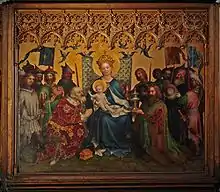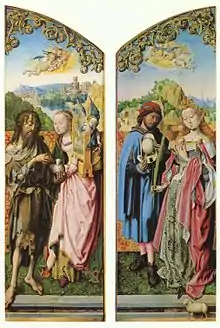Cologne School of Painting
The term Cologne School of Painting was first applied in the 19th century to describe old German paintings generally. It subsequently came to refer more specifically to painters who had their workshops in medieval Cologne and the lower-Rhine region from about 1300 to 1550 (Clarke and Clarke 2001; Meyer 1902–13).

Style periods

Initially smaller altarpieces such as the Klaren Altar in the Cologne Cathedral from about 1360–70 were created, based on book paintings from around the year 1300 (Zehnder 1989, 32). The mid-15th century is the high-point of this school, when Stefan Lochner (active 1442–1451) created the Altar of the City Patrons, which is considered to be the greatest masterpiece of the Cologne School (Zehnder 1989, 61). A third creative period followed, under the influence of Netherlandish painters such as Rogier van der Weyden (Zehnder 1989, 69, 73). Rogier's influence is especially notable in the work of the outstanding representative of this final phase, the anonymous painter known as the Master of the Saint Bartholomew Altarpiece. For example, the latter's large Deposition of Christ resembles the same theme represented in the former's Escorial altarpiece, and the Master's heightened naturalism and emphasis on tear-stained features reflect Rogier's emotionalism (Richards 2001).
Painters of the Cologne School
The artists of the Cologne School include Stefan Lochner and William of Cologne, as well as a number of artists identified only by the works they created:
- Meister des Aachener Altars
- Master of the Saint Bartholomew Altarpiece
- Meister der Heisterbacher Altars
- Meister der Ursulalegende
- Meister von St. Severin
- Meister von St. Laurenz
- Meister der Georgslegende
- Master of the Life of the Virgin
- Meister der Heiligen Sippe der Ältere
- Meister der Heiligen Veronika
- Meister der Verherrlichung Mariae
- Meister der kleinen Passion
- Meister der Lyversberger Passion
- Master of the Wasservass Calvary
- Meister der zwölf Apostel
- Meister des Palanter Altars
- Master of the Sinzig Calvary
The Cologne artists' quarter
The Cologne painters worked mainly in the area of Old Cologne around the Schildergasse, the artists' quarter, where sign painters were also active (Schnorrenberg 1898).
References
- Clarke, Michael, and Deborah Clarke. 2001. "Cologne School". The Concise Oxford Dictionary of Art Terms. Oxford and New York: Oxford University Press.
- Meyer, Hermann Julius. 1902–13. "Kölnische Malerschule". In: Meyers Großes Konversations-Lexikon, sixth edition, 11:282. Leipzig: Bibliographisches Institut.
- Richards, John C. 2001. "Master of the S. Bartholomew Altarpiece". In The Oxford Companion to Western Art, edited by Hugh Brigstocke. Oxford and New York: Oxford University Press. ISBN 978-0-19-866203-7.
- Schnorrenberg, Jakob. 1898. "Wilhelm von Herle". In Allgemeine Deutsche Biographie 43, 224–26. Leipzig: Duncker & Humblot.
- Zehnder, Frank Günter. 1989. Gotische Malerei in Köln: Altkölner Bilder von 1300 bis 1550. Wallraf-Richartz-Museum: Bildhefte zur Sammlung 3. Cologne: Wallraf-Richartz Museum.
Further reading
- Bloch, Peter, and Hermann Schitzler. 1967–70: Die Ottonische Kölner Malerschule, 2 vols. Düsseldorf: Verlag L. Schwann.
- Brockmann, Harald. 1932. Die Spätzeit der Kölner Malerschule. Der Meister von St. Severin und der Meister der Ursulalegende. Jahresgabe des Kreises der Rheinischen Heimatfreunde. Forschungen zur Kunstgeschichte Westeuropas 6. Bonn and Leipzig: Schröder.
- Budde, Rainer. 1986. Köln und seine Maler 1300–1500. DuMont Dokumente. Cologne: DuMont Buchverlag. ISBN 9783770118922.
- Budde, Rainer, and Roland Krischel (eds). 2001. Genie ohne Namen. Der Meister des Bartholomäus-Altars. Cologne: DuMont Buchverlag. ISBN 978-3-7701-5299-5 (trade book edition); ISBN 978-3-7701-5300-8 (exhibition catalog edition).
- Corley, Brigitte. 2009: Maler und Stifter des Spätmittelalters in Köln 1300-1500. Kiel: Verlag Ludwig. ISBN 9783937719788.
- Förster, Otto H. 1927. Die Meisterwerke der alten Kölner Malerschule im Wallraf-Richartz-Museum. Cologne: Kölner Verlagsanstalt.
- Merlo, Johann Jacob. 1852. Nachrichten von dem Leben und den Werken Kölnischer Künstler, vol. 2: Die Meister der altkölnischen Malerschule. Cologne: J. M. Heberle.
- Reiners, Heribert. 1925. Die Kölner Malerschule. Monographien zur Geschichte der christlichen Kunst 5. Gladbach: B. Kühlen Kunst- und Verlagsanstalt.
- Scheibler, Ludwig Adolf, and Carl Aldenhoven. 1902. Geschichte der Kölner Malerschule. Publikationen der Gesellschaft für Rheinische Geschichtskunde 13. Lübeck: J. Nöhring.
- Stange, A. 1967. Kritisches Verzeichnis der deutschen Tafelbilder vor Dürer, vol. 1: Köln, Niederrhein, Westfalen, Hamburg, Lübeck und Niedersachsen. Bruckmanns Beiträge zur Kunstwissenschaft. Munich: Bruckmann.
